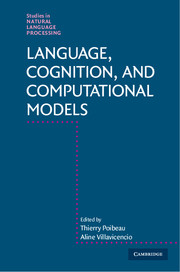Refine search
Actions for selected content:
3326 results in Artificial Intelligence and Natural Language Processing
Term variation in specialised corpora: Characterisation, automatic discovery and applications, by B. Daille John Benjamins Publishing Company (Terminology and Lexicography Research and Practice), 2017
-
- Journal:
- Natural Language Engineering / Volume 24 / Issue 2 / March 2018
- Published online by Cambridge University Press:
- 11 December 2017, pp. 313-315
-
- Article
- Export citation
NLE volume 24 issue 1 Cover and Back matter
-
- Journal:
- Natural Language Engineering / Volume 24 / Issue 1 / January 2018
- Published online by Cambridge University Press:
- 08 December 2017, pp. b1-b4
-
- Article
-
- You have access
- Export citation
NLE volume 24 issue 1 Cover and Front matter
-
- Journal:
- Natural Language Engineering / Volume 24 / Issue 1 / January 2018
- Published online by Cambridge University Press:
- 08 December 2017, pp. f1-f2
-
- Article
-
- You have access
- Export citation
Editorial note
-
- Journal:
- Natural Language Engineering / Volume 24 / Issue 1 / January 2018
- Published online by Cambridge University Press:
- 08 December 2017, p. 1
-
- Article
-
- You have access
- HTML
- Export citation

Language, Cognition, and Computational Models
-
- Published online:
- 30 November 2017
- Print publication:
- 25 January 2018
A survey of diacritic restoration in abjad and alphabet writing systems
-
- Journal:
- Natural Language Engineering / Volume 24 / Issue 1 / January 2018
- Published online by Cambridge University Press:
- 20 November 2017, pp. 123-154
-
- Article
- Export citation
Formalizing Natural Languages: The NooJ Approach, by Max Silberztein . London, Cognitive science series, Wiley-ISTE, UK, 2016. ISBN 9781848219021
-
- Journal:
- Natural Language Engineering / Volume 24 / Issue 1 / January 2018
- Published online by Cambridge University Press:
- 02 November 2017, pp. 161-162
-
- Article
- Export citation
Unsupervised learning of semantic representation for documents with the law of total probability
-
- Journal:
- Natural Language Engineering / Volume 24 / Issue 4 / July 2018
- Published online by Cambridge University Press:
- 02 November 2017, pp. 491-522
-
- Article
- Export citation
Exploring open information via event network†
-
- Journal:
- Natural Language Engineering / Volume 24 / Issue 2 / March 2018
- Published online by Cambridge University Press:
- 26 October 2017, pp. 199-220
-
- Article
- Export citation
NLE volume 23 issue 6 Cover and Front matter
-
- Journal:
- Natural Language Engineering / Volume 23 / Issue 6 / November 2017
- Published online by Cambridge University Press:
- 12 October 2017, pp. f1-f2
-
- Article
-
- You have access
- Export citation
NLE volume 23 issue 6 Cover and Back matter
-
- Journal:
- Natural Language Engineering / Volume 23 / Issue 6 / November 2017
- Published online by Cambridge University Press:
- 12 October 2017, pp. b1-b4
-
- Article
-
- You have access
- Export citation
Emerging trends: A tribute to Charles Wayne
-
- Journal:
- Natural Language Engineering / Volume 24 / Issue 1 / January 2018
- Published online by Cambridge University Press:
- 09 October 2017, pp. 155-160
-
- Article
-
- You have access
- Open access
- HTML
- Export citation
New treebank or repurposed? On the feasibility of cross-lingual parsing of Romance languages with Universal Dependencies†
-
- Journal:
- Natural Language Engineering / Volume 24 / Issue 1 / January 2018
- Published online by Cambridge University Press:
- 06 October 2017, pp. 91-122
-
- Article
- Export citation
DEXTER: A workbench for automatic term extraction with specialized corpora†
-
- Journal:
- Natural Language Engineering / Volume 24 / Issue 2 / March 2018
- Published online by Cambridge University Press:
- 05 October 2017, pp. 163-198
-
- Article
- Export citation
11 - Multiagent Systems
- from Part III - Reasoning, Learning and Acting with Uncertainty
-
- Book:
- Artificial Intelligence
- Published online:
- 12 August 2019
- Print publication:
- 25 September 2017, pp 521-548
-
- Chapter
- Export citation
13 - Individuals and Relations
- from Part IV - Reasoning, Learning and Acting with Individuals and Relations
-
- Book:
- Artificial Intelligence
- Published online:
- 12 August 2019
- Print publication:
- 25 September 2017, pp 581-644
-
- Chapter
- Export citation
2 - Agent Architectures and Hierarchical Control
- from Part I - Agents in the World: What are Agents and How Can They be Built?
-
- Book:
- Artificial Intelligence
- Published online:
- 12 August 2019
- Print publication:
- 25 September 2017, pp 49-74
-
- Chapter
- Export citation
Part II - Reasoning, Planning and Learning with Certainty
-
- Book:
- Artificial Intelligence
- Published online:
- 12 August 2019
- Print publication:
- 25 September 2017, pp 75-76
-
- Chapter
- Export citation
16 - Retrospect and Prospect
- from V - Retrospect and Prospect
-
- Book:
- Artificial Intelligence
- Published online:
- 12 August 2019
- Print publication:
- 25 September 2017, pp 731-744
-
- Chapter
- Export citation
6 - Planning with Certainty
- from Part II - Reasoning, Planning and Learning with Certainty
-
- Book:
- Artificial Intelligence
- Published online:
- 12 August 2019
- Print publication:
- 25 September 2017, pp 239-266
-
- Chapter
- Export citation
